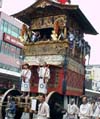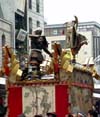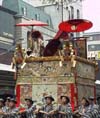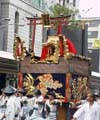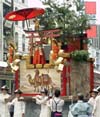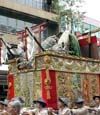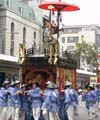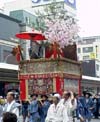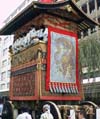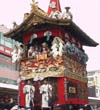
Naginata hoko
The head of Yamahoko Jyunkou (Yamahoko procession).
Naginatahoko is only hoko with real child on it. Other hokos use dolls for child.
"Naginata" means "a long sword". Naginata hoko put a long sword on its top.
Its creation was 1441 A.D.
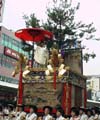
Hakurakuten yama
Hakurakuten was a poet from China.
Its former tapestry made in 16th century.
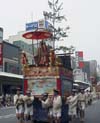
Urade yama
Urade yama celebrates Zinguu kougou (Empress Zinguu) and its doll with fishing rod is modeled her.
It was popular with townsmen.
Three most scenic spots in Japan are drawn on its former and side tapestry.
Urade yama provides talisman for easy delivery.
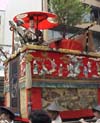
Hakuga yama
Hakuga was a artist for koto (oriental harp) from Zhou (China).
When he heard about his friend's death, he cut the string of koto.
This yama modeled his performance.
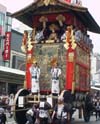
Kanko hoko (Kanko boko)
A bureaucracy from Qin (China) wanted to pass a gate called "Kanko" in a hurry.
But gate won't open till first chicken's cry.
Since he pretended chicken's cry, gate Kanko was opened. He could go through the gate safety.

Araretenjin yama
In eary 16th century, there was a massive fire in Kyoto.
But due to the sudden hail, it was extinguished in this town.
With hail, Tanjin (a god governs heaven) come down.
Then,town people honor Tenjin.
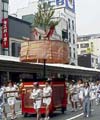
Shijyou kasa hoko
Kasa hoko is old type of Hoko. This hoko indicates the aspect of hoko in 15th century.
While Yamahoko Jyunkou, 8 children dances with poles in front of hoko.
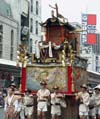
Tourou yama
Also known as "Kamakiri yama" means "rearhorse".
A wind-up rearhorse is on the top of yama which moves while Yamahoko Jyunkou.
This yama admires rearhorse's bravery.
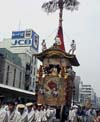
Kikusui hoko
Kikusuihoko named after Kikusui-i (well) in the neighborhood.
This hoko was restored in 1952. It has a lot of beautiful decors.
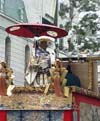
Mousou yama
Also known as "Takenoko yama" means "bamboo sprout".
Mousou is one of a filial piety man lived in early China.
He made a search for bamboo sprouts in the deep snow for his diseased mother.
Finally he picked out a bamboo sprout, then his mother got well.

Yamabushi yama
"Yamabushi" means "mountain priest".
Once upon a time, Yasaka tower slanted.
But a yamabushi came to tower and fixed it up with curious power.
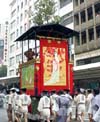
Kakkyo yama
Kakkyo who lived eary China was too poor to feed his mother and child.
When he buried his child alive in the moutains, he find an ax made of gold.
After that he performed filial duty to his mother.
Kakkyo yama is a only yama with roof.
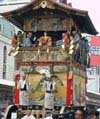
Niwatori hoko
"Niwatori" means "a chicken".
In ancient China, a long pacific era prevent to use the drum for indictment.
The Chicken build a nest in the unused drum.
Its back tapestry was made in Belgium in 16th century.
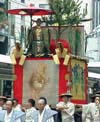
Ashikari yama
"Ashikari" means "reaping reeds".
There were a dirt poor husband and wife in Naniwa (Osaka).
The wife work away, and the husband sell the bunch of reeds.
Ashikari yama expresses the old husband reaping reeds.
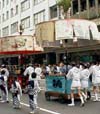
Aya kasa hoko
This is the very old type hoko.
When they perform Yamahoko Jyunkou, children dance with poles to the music played with the bells, the drums and the whistles.
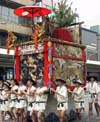
Tokusa yama
"Tokusa" is a name of the plant used for edging blades.
Tokusa yama represents an old man reaping tokusa in Shinano (Nagano).
The doll of old man bears a sickle and tokusa.
He is reminding his child lived apart.
The doll was made in 17th century.
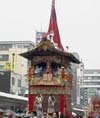
Tsuki hoko
"Tsuki" means "moon".
Tsuki hoko celebrates "Tsukuyomi no mikoto" who is a Japanese god govern moon.
Tsukuyomi no mikoto is a sibling of Amaterasu and Susanowo.
Golden crescent is decorated at the top of the hoko.
Tsuki hoko is one of the most luxurious hoko.
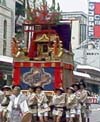
Aburatenjin yama
This yama's "Tenjin" means "Michizane Sugawara" who is a famous academian lived in 9th century.
An admirable red guard frame with some red Ume (Japanese plum) branch puts on it.
Ume was Michizane's favorite.
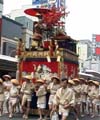
Houshou yama
In former years, Houshou yama called "Hana nusubito yama". It means "Yama of flower thief".
Houshou lived in Kyoto about 1000 years ago.He was a brilliant man with abundant talents.
One day, Izumishikibu who was his loved woman asked him to bring her Ume flower from the conference hall.
He plundered a branch of Ume from the hall at risk.
Houshou yama provides talismans and charms for love knot or marriage tie.

Taishi yama
"Taishi" means "Shotoku Taishi (Prince Shotoku)" who was a Emperor's son and a great politician lived in 6th to 7th century.
He walked around mountains to look for the good lumber to build a temple for four heavenly kings.
Taishi yama gives talismans for knowledge.
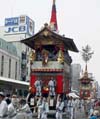
Houka hoko
"Houka" is a name of a bonze. His statue is honored on this hoko.
At the top of hoko, there is a ornament of "sankou" means "three light ; sun, moon, star".
Also, wind-up doll called "Sankoumaru" in on the hoko as Yamahoko Jyunkou. It can dance.

Iwato yama
Because of Susanowo no Mikoto's rowdy behavior, his sister Amaterasu Oomikami (Goddess of the Sun) hid herself in Amano Iwato.
Then it blacked out whole world.
Under the uncomfortable situation, multitudinous gods gathered in front of the Amano Iwato and banqueted for three days.
Amaterasu wanted to see what they do and opened the Iwato a bit.
Since Amaterasu was pulled out, the sun came back.
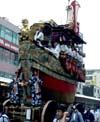
Fune hoko (Funa hoko)
"Fune" means "the ship"
Zinguu Kougou(Empress Zinguu)'s outgoing vessel is the theme of Fune hoko.
She is the legendary Empress In ancient times.
After Yamahoko Jyunkou, Fune hoko provides talismans for easy delivery.
